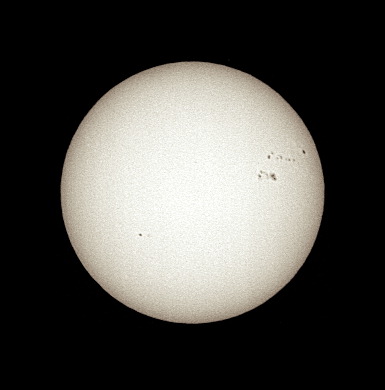Photosphere is sometimes called solar surface. The Sun, of course,
has no solid surface. Photosphere is only the layer radiating visible light
into the space.
The zone
under the photosphere
is opaque and the energy is transported through it by convection (ascending and
descending flows - "boiling motion"). Photosphere is very thin - about 300 km.
It has got white color, because it is the standard light source and human eye
is "calibrated" to its light. The photosphere is of granular structure.
Particular granules are the tops of ascending convective flows. The most
conspicuous features in solar photosphere are
sunspots. The abundance frequency of sunspots
is governed by the
11-year solar cycle.
Sunspots are magnetic regions with field intensity thousands
times stronger than the Earth's magnetic field. Sunspots usually appear
in groups with two sets of spots. One set is of the north magnetic field
polarity while the other one is of south magnetic field polarity.
The magnetic field is the strongest in the darker central part of the sunspot which
is called umbra and it is weaker in the lighter part which is called penumbra.
The temperature in photosphere is approximately 5800 K but the temperature in
sunspots is much lower - about 4000 K. The color of sunspots seems to be black
because their radiation is much lower in comparison to their surroundings. In fact, their
color is red. Sunspots are usually surrounded by faculae. Faculae are bright areas
which are easily seen near the solar limb.
Sunspots, faculae and granulation can be seen on image taken with my Maksutov - Cassegrain
telescope. Special very thin foil decreasing the solar radiation about 1,000,000 times
was used as a safe filter for viewing and taking the photography.
